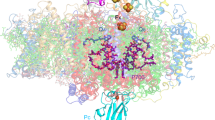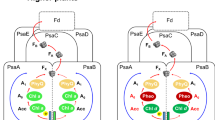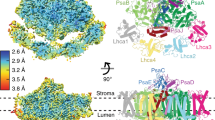Abstract
All higher organisms on Earth receive energy directly or indirectly from oxygenic photosynthesis performed by plants, green algae and cyanobacteria. Photosystem I (PSI) is a supercomplex of a reaction centre and light-harvesting complexes. It generates the most negative redox potential in nature, and thus largely determines the global amount of enthalpy in living systems. We report the structure of plant PSI at 3.4 Å resolution, revealing 17 protein subunits. PsaN was identified in the luminal side of the supercomplex, and most of the amino acids in the reaction centre were traced. The crystal structure of PSI provides a picture at near atomic detail of 11 out of 12 protein subunits of the reaction centre. At this level, 168 chlorophylls (65 assigned with orientations for Qx and Qy transition dipole moments), 2 phylloquinones, 3 Fe4S4 clusters and 5 carotenoids are described. This structural information extends the understanding of the most efficient nano-photochemical machine in nature.
This is a preview of subscription content, access via your institution
Access options
Subscribe to this journal
Receive 51 print issues and online access
$199.00 per year
only $3.90 per issue
Buy this article
- Purchase on Springer Link
- Instant access to full article PDF
Prices may be subject to local taxes which are calculated during checkout




Similar content being viewed by others
References
Barber, J. Engine of life and big bang of evolution: a personal perspective. Photosynth. Res. 80, 137–155 (2004)
Nelson, N. & Ben-Shem, A. The complex architecture of oxygenic photosynthesis. Nature Rev. Mol. Cell Biol. 5, 971–982 (2004)
Nelson, N. & Ben-Shem, A. The structure of photosystem I and evolution of photosynthesis. Bioessays 27, 914–922 (2005)
Jordan, P. et al. Three-dimensional structure of cyanobacterial photosystem I at 2.5 Å resolution. Nature 411, 909–917 (2001)
Kurisu, G., Zhang, H., Smith, J. L. & Cramer, W. A. Structure of the cytochrome b6f complex of oxygenic photosynthesis: tuning the cavity. Science 302, 1009–1014 (2003)
Ferreira, K. N., Iverson, T. M., Maghlaoui, K., Barber, J. & Iwata, S. Architecture of the photosynthetic oxygen-evolving center. Science 303, 1831–1838 (2004)
Loll, B., Kern, J., Saenger, W., Zouni, A. & Biesiadka, J. Towards complete cofactor arrangement in the 3.0 Å resolution structure of photosystem II. Nature 438, 1040–1044 (2005)
Nelson, N. & Yocum, C. Structure and function of photosystems I and II. Annu. Rev. Plant Biol. 57, 521–565 (2006)
Stroebel, D., Choquet, Y., Popot, J. L. & Picot, D. An atypical haem in the cytochrome b6f complex. Nature 426, 413–418 (2003)
Liu, Z. et al. Crystal structure of spinach major light-harvesting complex at 2.72 Å resolution. Nature 428, 287–292 (2004)
Standfuss, J., Terwisscha van Scheltinga, A. C., Lamborghini, M. & Kuhlbrandt, W. Mechanisms of photoprotection and nonphotochemical quenching in pea light-harvesting complex at 2.5 Å resolution. EMBO J. 24, 919–928 (2005)
Ben-Shem, A., Nelson, N. & Frolow, F. Crystallization and initial X-ray diffraction studies of higher plant photosystem I. Acta Crystallogr. D 59, 1824–1827 (2003)
Ben-Shem, A., Frolow, F. & Nelson, N. The crystal structure of plant photosystem I. Nature 426, 630–635 (2003)
Scheller, H. V., Jensen, P. E., Haldrup, A., Lunde, C. & Knoetzel, J. Role of subunits in eukaryotic Photosystem I. Biochim. Biophys. Acta 1507, 41–60 (2001)
Jensen, P. E., Haldrup, A., Zhang, S. & Scheller, H. V. The PSI-O subunit of plant photosystem I is involved in balancing the excitation pressure between the two photosystems. J. Biol. Chem. 279, 24212–24217 (2004)
Khrouchtchova, A. et al. A previously found thylakoid membrane protein of 14 kDa (TMP14) is a novel subunit of plant photosystem I and is designated PSI-P. FEBS Lett. 579, 4808–4812 (2005)
Zygadlo, A., Robinson, C., Scheller, H. V., Mant, A. & Jensen, P. E. The properties of the positively charged loop region in PSI-G are essential for its “spontaneous” insertion into thylakoids and rapid assembly into the photosystem I complex. J. Biol. Chem. 281, 10548–10554 (2006)
Ben-Shem, A., Frolow, F. & Nelson, N. Evolution of Photosystem I—from symmetry through pseudosymmetry to asymmetry. FEBS Lett. 564, 274–280 (2004)
Lunde, C. P., Jensen, P. E., Haldrup, A., Knoetzel, J. & Scheller, H. V. The PSI-H subunit of photosystem I is essential for state transitions in plant photosynthesis. Nature 408, 613–615 (2000)
Dashdorj, N., Xu, W., Cohen, R. O., Golbeck, J. H. & Savikhin, S. Asymmetric electron transfer in cyanobacterial Photosystem I: charge separation and secondary electron transfer dynamics of mutations near the primary electron acceptor A0. Biophys. J. 88, 1238–1249 (2005)
Joliot, P. & Joliot, A. In vivo analysis of the electron transfer within photosystem I: are the two phylloquinones involved? Biochemistry 38, 11130–11136 (1999)
Jolley, C., Ben-Shem, A., Nelson, N. & Fromme, P. Structure of plant photosystem I revealed by theoretical modeling. J. Biol. Chem. 280, 33627–33636 (2005)
Morosinotto, T., Ballottari, M., Klimmek, F., Jansson, S. & Bassi, R. The association of the antenna system to photosystem I in higher plants. Cooperative interactions stabilize the supramolecular complex and enhance red-shifted spectral forms. J. Biol. Chem. 280, 31050–31058 (2005)
Ben-Shem, A., Frolow, F. & Nelson, N. Light-harvesting features revealed by the structure of plant photosystem I. Photosynth. Res 81, 239–250 (2004)
Ganeteg, U., Strand, A., Gustafsson, P. & Jansson, S. The properties of the chlorophyll a/b-binding proteins Lhca2 and Lhca3 studied in vivo using antisense inhibition. Plant Physiol. 127, 150–158 (2001)
Schmid, V. H., Paulsen, H. & Rupprecht, J. Identification of N- and C-terminal amino acids of Lhca1 and Lhca4 required for formation of the heterodimeric peripheral photosystem I antenna LHCI-730. Biochemistry 41, 9126–9131 (2002)
Ihalainen, J. A. et al. Pigment organization and energy transfer dynamics in isolated photosystem I (PSI) complexes from Arabidopsis thaliana depleted of the PSI-G, PSI-K, PSI-L, or PSI-N subunit. Biophys. J. 83, 2190–2201 (2002)
Durnford, D. G. et al. A phylogenetic assessment of the eukaryotic light-harvesting antenna proteins, with implications for plastid evolution. J. Mol. Evol. 48, 59–68 (1999)
Morosinotto, T., Castelletti, S., Breton, J., Bassi, R. & Croce, R. Mutation analysis of Lhca1 antenna complex. Low energy absorption forms originate from pigment–pigment interactions. J. Biol. Chem. 277, 36253–36261 (2002)
Anderson, J. M., Chow, W. S. & Park, Y.-I. The grand design of photosynthesis: acclimation of the photosynthetic apparatus to environmental cues. Photosynth. Res 46, 129–139 (1995)
Bailey, S., Walters, R. G., Jansson, S. & Horton, P. Acclimation of Arabidopsis thaliana to the light environment: the existence of separate low light and high light responses. Planta 213, 794–801 (2001)
Mozzo, M., Morosinotto, T., Bassi, R. & Croce, R. Probing the structure of Lhca3 by mutation analysis. Biochim. Biophys. Acta. 1757, 1607–1613 (2006).
Ikeuchi, M. & Inoue, Y. Two new components of 9 and 14 kDa from spinach photosystem I complex. FEBS Lett. 280, 332–334 (1991)
He, W. Z. & Malkin, R. Specific release of a 9-kDa extrinsic polypeptide of photosystem I from spinach chloroplasts by salt washing. FEBS Lett. 308, 298–300 (1992)
Knoetzel, J. & Simpson, D. J. The primary structure of a cDNA for PsaN, encoding an extrinsic lumenal polypeptide of barley photosystem I. Plant Mol. Biol. 22, 337–345 (1993)
Jansson, S., Andersen, B. & Scheller, H. V. Nearest-neighbor analysis of higher-plant photosystem I holocomplex. Plant Physiol. 112, 409–420 (1996)
Haldrup, A., Naver, H. & Scheller, H. V. The interaction between plastocyanin and photosystem I is inefficient in transgenic Arabidopsis plants lacking the PSI-N subunit of photosystem I. Plant J. 17, 689–698 (1999)
Lucinski, R., Schmid, V.H., Jansson, S. & Klimmek, F. Lhca5 interaction with plant photosystem I. FEBS Lett. 580, 6485–6488 (2006); published online 7 November 2006.
Bellafiore, S., Barneche, F., Peltier, G. & Rochaix, J. D. State transitions and light adaptation require chloroplast thylakoid protein kinase STN7. Nature 433, 892–895 (2005)
Kyle, D. J., Staehelin, L. A. & Arntzen, C. J. Lateral mobility of the light-harvesting complex in chloroplast membranes controls excitation energy distribution in higher plants. Arch. Biochem. Biophys. 222, 527–541 (1983)
Allen, J. F. Cyclic, pseudocyclic and noncyclic photophosphorylation: new links in the chain. Trends Plant Sci. 8, 15–19 (2003)
Consoli, E., Croce, R., Dunlap, D. D. & Finzi, L. Diffusion of light-harvesting complex II in the thylakoid membranes. EMBO Rep. 6, 782–786 (2005)
Kouril, R. et al. Structural characterization of a complex of photosystem I and light-harvesting complex II of Arabidopsis thaliana. Biochemistry 44, 10935–10940 (2005)
Haldrup, A., Jensen, P. E., Lunde, C. & Scheller, H. V. Balance of power: a view of the mechanism of photosynthetic state transitions. Trends Plant Sci. 6, 301–305 (2001)
Kargul, J. et al. Light-harvesting complex II protein CP29 binds to photosystem I of Chlamydomonas reinhardtii under State 2 conditions. FEBS J. 272, 4797–4806 (2005)
Takahashi, H., Iwai, M., Takahashi, Y. & Minagawa, J. Identification of the mobile light-harvesting complex II polypeptides for state transitions in Chlamydomonas reinhardtii. Proc. Natl Acad. Sci. USA 103, 477–482 (2006)
Trissl, H.-W. & Wilhelm, C. Why do thylakoid membranes from higher plants form grana stacks? Trends Biochem. Sci. 18, 415–419 (1993)
Sener, M. K. et al. Evolution of the excitation transfer network in photosystem I from cyanobacteria to plants. Biophys. J. 89, 1630–1642 (2005)
Amunts, A., Ben-Shem, A. & Nelson, N. Solving the structure of plant photosystem I—biochemistry is vital. Photochem. Photobiol. Sci. 4, 1011–1015 (2005)
Acknowledgements
We thank the ESRF for synchrotron beam time, and staff scientists of the ID 14, ID 29 and ID 23 station clusters for their assistance. We also thank F. Frolow and J. Hirsh for valuable guidance and advice in crystallography. This work was supported by The Israel Science Foundation.
Atomic coordinates and structure factor files were deposited in the Protein Data Bank under accession number 2O01.
Author information
Authors and Affiliations
Corresponding author
Ethics declarations
Competing interests
Reprints and permissions information is available at www.nature.com/reprints. The authors declare no competing financial interests.
Supplementary information
Supplementary Information
This file contains Supplementary Notes, Supplementary Tables S1-S2, Supplementary Figures S1-S3 with Legends and additional references. (PDF 10976 kb)
Rights and permissions
About this article
Cite this article
Amunts, A., Drory, O. & Nelson, N. The structure of a plant photosystem I supercomplex at 3.4 Å resolution. Nature 447, 58–63 (2007). https://doi.org/10.1038/nature05687
Received:
Accepted:
Issue Date:
DOI: https://doi.org/10.1038/nature05687
This article is cited by
-
Spectral diversity of photosystem I from flowering plants
Photosynthesis Research (2023)
-
Competition between intra-protein charge recombination and electron transfer outside photosystem I complexes used for photovoltaic applications
Photochemical & Photobiological Sciences (2022)
-
Metabolome and transcriptome profiling reveals anthocyanin contents and anthocyanin-related genes of chimeric leaves in Ananas comosus var. bracteatus
BMC Genomics (2021)
-
Cryo-EM photosystem I structure reveals adaptation mechanisms to extreme high light in Chlorella ohadii
Nature Plants (2021)
-
FRET theoretical predictions concerning freely diffusive dyes inside spherical container: how to choose the best pair?
Photochemical & Photobiological Sciences (2021)
Comments
By submitting a comment you agree to abide by our Terms and Community Guidelines. If you find something abusive or that does not comply with our terms or guidelines please flag it as inappropriate.



